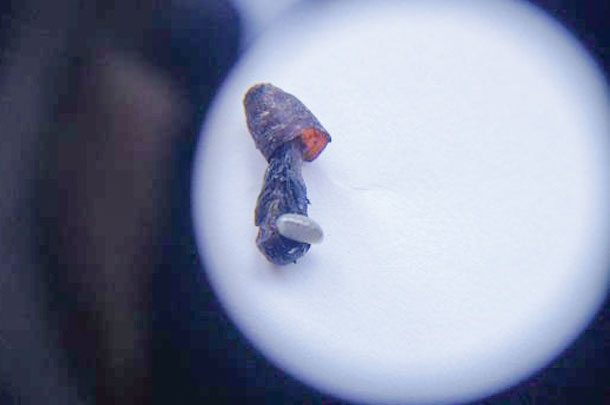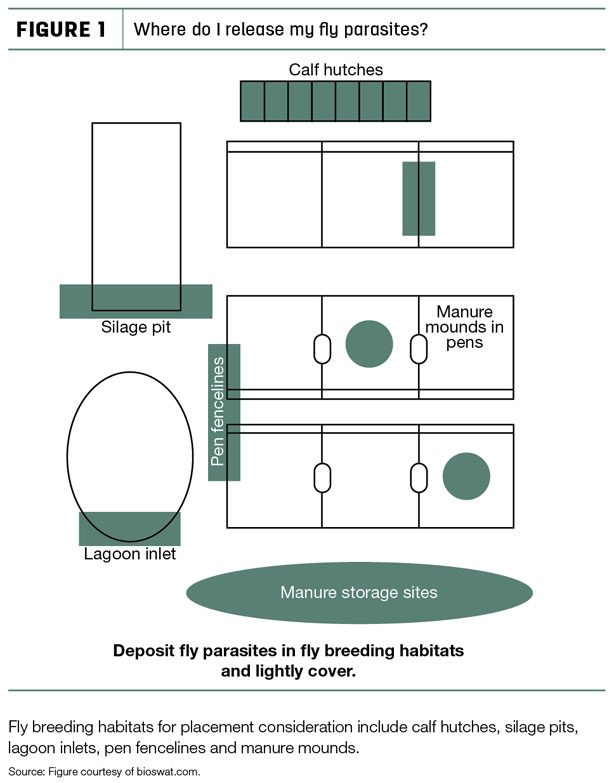With that many cattle in one area, you would think the flies would be out-of-control nasty, but they’re not.
How is this possible? Through consistent manure management and using biological warfare – namely, using parasitic wasps.
Using parasitic wasps to control flies has to do with the circle of life. Flies lay eggs which become pupae, parasitic wasps lay their own eggs in the pupae, feeding on it and, eventually, three weeks later, their eggs hatch and the parasitic wasp begins its own cycle.
Insects are the dominant life form on earth, where millions may exist on a single acre of land. About 1 million species have been described, and there may be as many as 10 times that may yet be identified.
Of all creatures on earth, insects play a major role in the breakdown of plant and animal material and constitute a major food source for many other animals. On the other hand, all insect pests have natural enemies. The use of these organisms to manage pests is known as biological control.
With the advent of synthetic insecticides in the 1950s, easy control of insect pests appeared at hand. However, it soon became obvious that there were problems associated with the use of insecticides. Some insect pests became resistant, and some non-target organisms were adversely affected, and pest resurgence occurred.
Additionally, environmental and health concerns arose. Today, the protection of food and fiber crops from insect, mite, disease and weed pests in conventional agricultural systems still relies heavily on the use of chemical pesticides.

Darr Feedlot uses parasitic wasps purchased from two different companies that are both industry leaders in this field with over 80 years of research between them – Kunafin in Texas and BioSwat in Colorado.
Calvin Van O’Linda, maintenance manager for Darr Feedlot, explains how the parasitic wasps work. “During fly season, from the first of June until October, we get the product (wasps) once a week,” he says. “It takes one person half a day to scatter the wasps throughout the feedlot in the same locations each week.”
The wasps come shipped in sawdust (BioSwat) or rice hulls (Kunafin) in bags, and they are so small that you really can’t see them, but they make a real difference to the fly population. “We sprinkle them out, and it doesn’t take much; if it is drier we use a side-by-side,” Van O’Linda says. “We’ve been doing this six years and we believe it works. We really like the results.”
He says that fly control really needs a multi-pronged approach, but using biological controls work very well for them.
“We are 7 miles from a town of any size, but we have neighbors,” Van O’Linda says. “People know the downsides of living near a feedlot, but we do the best job we can for our neighbors.”
He says that flies are money robbers, and they do their best to control them, but even then it isn’t all about the parasitic wasps – they also do their best to ensure that there is very little habitat for the flies. “We pride ourselves on weed control and get rid of any unneeded plant which could possibly be habitation for flies,” he says.
“We take out any unnecessary plants in our drains, any unnecessary trees, and we keep our feed separate from our cattle areas. We like to stay on top of things as best we can.”
The parasitic wasps that Darr Feedlot uses in one of their feedlots were developed by Frank Junfin, who was one of the first graduates of the Texas A&M entomology program. While there, he worked in several pioneering enterprises using insects as biological controls.
In 1975, he began a company called Kunafin to produce and supply beneficial insects for biological integrated control. Currently, Kunafin is family owned-and-operated with multiple entomologists on-site to help their customers.
“We are not bug sales people,” Junfin says. “We are more like veterinarians or consultants. You have to do other things besides the bugs; we are just another resource – someone you can rely on.”
Junfin first became interested in bugs through his father, who would go out into farmers’ fields where they were spraying for pests. He would point out that their fields were already pest-free, thanks to beneficial bugs, prior to spraying and ended up saving the farmers quite a bit of money.
Junfin would travel with his father and became very interested in the benefits of using bugs to fight other bugs – and eventually went on to do his groundwork studies and then formation of his company.
The other feedlot that Van O’Linda oversees also uses a parasitic wasp from a competing company owned by Matt Grange from Boulder, Colorado, called BioSwat, where they have also been selling parasitic wasps since 1975.
“My dad was a consulting nutritionist,” Grange says. “He saw how the parasitic wasps work and developed that idea to the point where we have grown into a solid, recognizable brand.”
BioSwat ships the wasps to the location where they will be utilized in heat-sealed plastic, breathable sacks, and nestled in wood shavings that helps maintain their viability. They guarantee 25,000 wasp units per bag. Kunafin ships 30,000 units per bag where they travel to their destination in rice hulls. Both companies look at the size of operation and take in other factors before a decision is made on how many wasps are necessary and how much those wasps will cost.
“Our pricing is based on a lot of factors,” Junfin says. “If a dairy is on a hill with good drainage, the pricing will be different than one on a marshy flat. We have entomologists on hand to help make that decision and, in some cases, will send someone out to make a determination.”
 When utilizing the wasps for fly control, Grange looks at two things: roosting habitats, like structures where sprays and other methods are more effective, and at other fly breeding habitats like manure areas or feed spill areas. He breaks the fly breeding habitats into primary, secondary and tertiary habitats.
When utilizing the wasps for fly control, Grange looks at two things: roosting habitats, like structures where sprays and other methods are more effective, and at other fly breeding habitats like manure areas or feed spill areas. He breaks the fly breeding habitats into primary, secondary and tertiary habitats.
“Primary areas have the highest concentration of fly breeding areas,” Grange says. “Undisturbed manure or feed spillage areas where food spoils are fly-rich habitats where you can find the greatest numbers of flies. Secondary would be areas where there is manure under fencelines, stored in mounds, spread in corners or in sloppy pens.
Tertiary is where we don’t bother going – dry manure, etc. Crusty manure with soupy material underneath is prime fly breeding habitat; also concrete feed pads where the moisture runs off and settles on the side.”
Grange says a feedlot needs a conscientious employee dedicated to doing the job right in order to make the parasitic wasps more effective. In feedlot operations with over a thousand cows, he recommends treatment every week; in smaller operations and some dairies, they can get away with treating every other week.
“It is important to realize that no method of insect control is 100 percent effective, including the use of powerful insecticides,” Junfin says. “Biological integrated control is no exception, but it has proven to be the most cost-effective and the only method that gives consistent long-term control of pest insects.” ![]()
PHOTO 1: Kunafin entomologist Blaine Junfin shows a developing fly parasite actually found in the feedlot.
PHOTO 2: A parasitic wasp feeds on fly pupae. Photos courtesy of Kunafin.
Becky Cook is a freelance writer from Iona, Idaho







